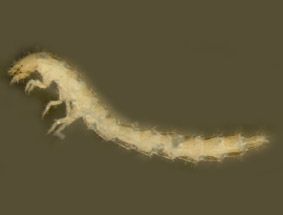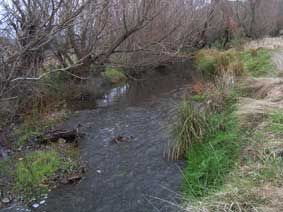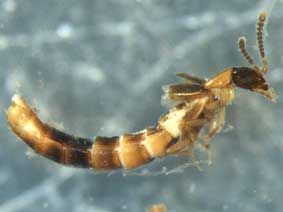Major Group: Insecta
Order: Coleoptera
Family: Staphylinidae |
Descriptive Features:
Adults
prothorax without notopleural sutures, ventral portion of the notum, (hypomeron) on each side joined directly to the sternum by notosternal suture and pleuron reduced and concealed
body narrowly elongate, length > 4 X width
elytra very short, exposing more than 4 complete abdominal tergites
abdomen with more than 3 ventrites
size:
Larvae
head prognathous or slightly declined
antennal length > ˝ head width
apex of antennal segment 2 oblique, so that sensorium arises proximad of segment 3
spiracles annular
maxillary palp 3-segmented
labrum separated from head capsule by complete suture
tergum 9 with articulated urogomphi
legs 5-segmented, including claw
size: up to 20mm |

|
Staphylinidae larva |
|
|

|
Staphylinidae adult |
|
Taxonomic Checklist: Subfamilies Genera
Oxytelinae
Bledius
Paederinae
Paederus sjoestedti Bernhauer
Oxytelinae
Stenus
|
|
Distribution: Australia wide
Sensitivity Rating: SIGNAL grade 3
Functional Feeding Group: unknown |

|
Little Snowy Creek at Eskdale, Vic |
|
|
Ecology: Commonly known as ‘rove’ or ‘shore’ beetles, Staphylinidae is essentially a terrestrial beetle family that is found almost exclusively very close to water or in very wet mud or sand.
Instream habitat: Staphylinid adults are considered terrestrial. Larvae appear to have more interaction with aquatic habitats. Stenus live in marshes and at the edge of streams and ponds. Bledius construct burrows in moist sand adjacent to rivers and lakes. Paederus lives in gravel at the edges of streams and rivers. Some Staphylinidae species may also live on top of emergent stones in streams.
Feeding ecology:The feeding behaviour of staphylinid beetles is not clear-cut. Generally, terrestrial adults are thought to be predators and some species associated with water feed on algae but the subfamily Oxytelinae (Stenus and Bledius) noted as detritivores, feeding on dead or decaying organic matter (although another reference notes Stenus as a predator). Many terrestrial species are attracted to dung, carrion, rotting fruit and decaying matter, but may actually feed on other organisms living within these materials. No information is available on the larvae.
Habit: Stenus and Paederus are able to run on the surface of the water. Stenus posses a unique adult prey capture mechanism. Bledius are typically gregarious.
Life history: |
| |
Information Sources: Lawrence & Britton 1991, Williams 1980, Mathews 1980, Jach 1998, Michaels 2007, C Watts pers. comm.
Key to Subfamilies: none
Key to Genera: none
Key to Species: none |

|
Staphylinidae adult - damaged |
|
|
|
|